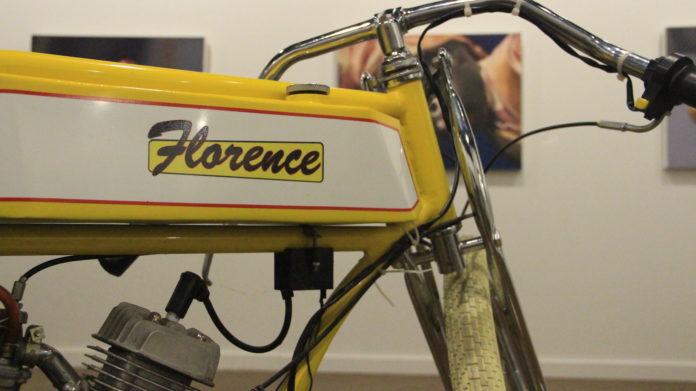
By Carson Lewis | Page One Editor
John Hartley’s recent exhibition “Played in America” explores the relationship between people and objects. The exhibit will be open until March 1 in the Martin Museum of Art.
The exhibit’s artist reception was held at the Martin Museum of Art Wednesday night, featuring the artist’s thoughts on his work — a collection of photographically inspired oil paintings.
Hartley’s 40-minute talk fluctuated from a question-and-answer session to his descriptions of the pieces in the exhibit, interspersed with short stories from his life and how they inspired the artwork.
“I’m going to go down some rabbit holes tonight, I’m sure,” Hartley said.
Bicycle to motorcycle
In the center of the exhibit sits “Florence,” a yellow motorbike with its title displayed in colorful font. The artist described how the piece related to his youth. His father owned a motorcycle repair shop where his grandfather was a mechanic.
He recounted the moment when his relationship with his grandfather grew—through their shared love of mechanics— as they would work on motorcycles together.
“He was amazed [by my work on motorcycles]. He knew we were connected genetically, right? So after that, we started working on motorcycles… Whenever he would tick off my grandmother by buying something like a motorcycle, he’d paint it yellow. My grandma’s favorite color was yellow. So it would be OK after that,” Hartley said.
The dichotomy of toy soldiers
At one point during the event, Hartley asked the audience whether one of his pieces, “Sightline,” was about play or war. The oil painting shows a toy soldier holding his weapon as if he is ready for action. When they answered, Hartley asked to hear their explanations.
One woman in the audience guessed “play” while another guessed “war.”
“Well guess what? You’re both right,” Hartley said.
The artist clarified later, telling art students in the audience to contemplate different interpretations of their work, using “Sightline” as an example.
“[The viewer’s] thought may be more interesting than your initial thought,” Hartley said.
White doll painted black
One of the oil paintings exhibited titled “My Best Friend” depicts a dark-skinned doll with chipped paint displayed sideways.
Hartley told the audience how he acquired the doll pictured, which his wife found for him while on a business trip.
“The doll was kind of scratched up. If you look at, it there’s some pink on the nose. That’s not something I created. It was actually a white doll-baby that was painted dark to match an African American’s complexion. So the baby-doll was made, in my mind, by a child,” Hartley said.
The piece is jarring in its display, with the head of the doll facing down. He said this choice of framing was intentional.
“This one… I actually wanted it to be uncomfortable. [Dolls], in general, are kind of weird toys. In fact, my wife calls them ‘soul suckers,’” Hartley said. “There is something really uncomfortable with them because some of them are so poorly styled, but as kids we fall in love with them— they’re a likeness of us. We don’t realize that they’re pretty inaccurate representations of us.”
A crowd of approximately 100 people stayed during the reception.
“It was a really nice size crowd. The thing that impressed me most about the event was the questions the students asked,” Elisa Crowder, gallery attendant, said. “Those were mainly art students, but not everybody who asked a question was an art student. I thought they asked really insightful questions, and things that will help them grow as [artists].”





